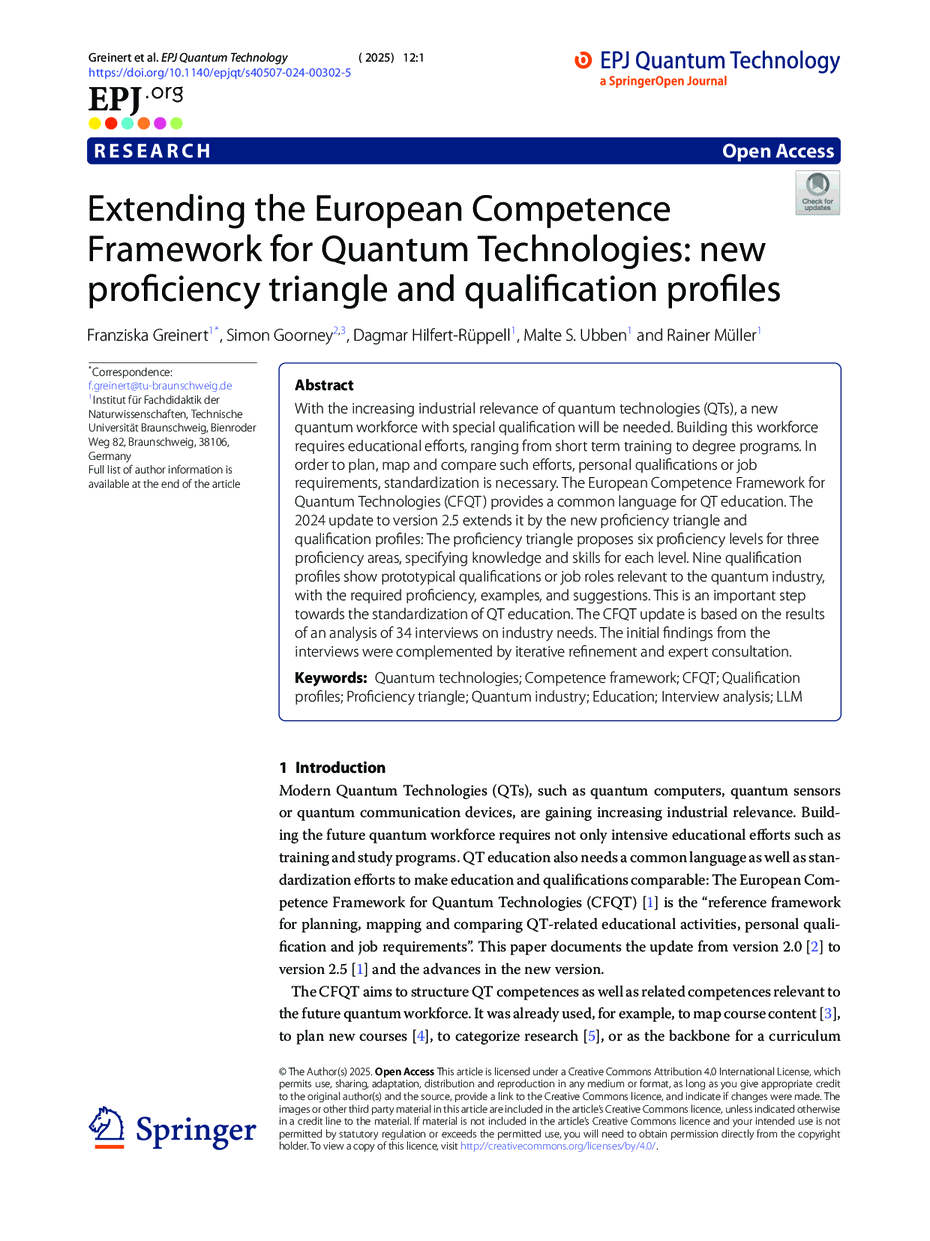https://doi.org/10.1140/epjqt/s40507-024-00302-5
Research
Extending the European Competence Framework for Quantum Technologies: new proficiency triangle and qualification profiles
1
Institut für Fachdidaktik der Naturwissenschaften, Technische Universität Braunschweig, Bienroder Weg 82, 38106, Braunschweig, Germany
2
Department of Management, Aarhus University, Fuglesangs Allé 4, 8000, Aarhus, Denmark
3
Niels Bohr Institute, Copenhagen University, Blegdamsvej 17, 2100, København, Denmark
a
f.greinert@tu-braunschweig.de
Received:
9
October
2024
Accepted:
23
December
2024
Published online:
7
January
2025
With the increasing industrial relevance of quantum technologies (QTs), a new quantum workforce with special qualification will be needed. Building this workforce requires educational efforts, ranging from short term training to degree programs. In order to plan, map and compare such efforts, personal qualifications or job requirements, standardization is necessary. The European Competence Framework for Quantum Technologies (CFQT) provides a common language for QT education. The 2024 update to version 2.5 extends it by the new proficiency triangle and qualification profiles: The proficiency triangle proposes six proficiency levels for three proficiency areas, specifying knowledge and skills for each level. Nine qualification profiles show prototypical qualifications or job roles relevant to the quantum industry, with the required proficiency, examples, and suggestions. This is an important step towards the standardization of QT education. The CFQT update is based on the results of an analysis of 34 interviews on industry needs. The initial findings from the interviews were complemented by iterative refinement and expert consultation.
Key words: Quantum technologies / Competence framework / CFQT / Qualification profiles / Proficiency triangle / Quantum industry / Education / Interview analysis / LLM
© The Author(s) 2025
 Open Access This article is licensed under a Creative Commons Attribution 4.0 International License, which permits use, sharing, adaptation, distribution and reproduction in any medium or format, as long as you give appropriate credit to the original author(s) and the source, provide a link to the Creative Commons licence, and indicate if changes were made. The images or other third party material in this article are included in the article’s Creative Commons licence, unless indicated otherwise in a credit line to the material. If material is not included in the article’s Creative Commons licence and your intended use is not permitted by statutory regulation or exceeds the permitted use, you will need to obtain permission directly from the copyright holder. To view a copy of this licence, visit http://creativecommons.org/licenses/by/4.0/.
Open Access This article is licensed under a Creative Commons Attribution 4.0 International License, which permits use, sharing, adaptation, distribution and reproduction in any medium or format, as long as you give appropriate credit to the original author(s) and the source, provide a link to the Creative Commons licence, and indicate if changes were made. The images or other third party material in this article are included in the article’s Creative Commons licence, unless indicated otherwise in a credit line to the material. If material is not included in the article’s Creative Commons licence and your intended use is not permitted by statutory regulation or exceeds the permitted use, you will need to obtain permission directly from the copyright holder. To view a copy of this licence, visit http://creativecommons.org/licenses/by/4.0/.





